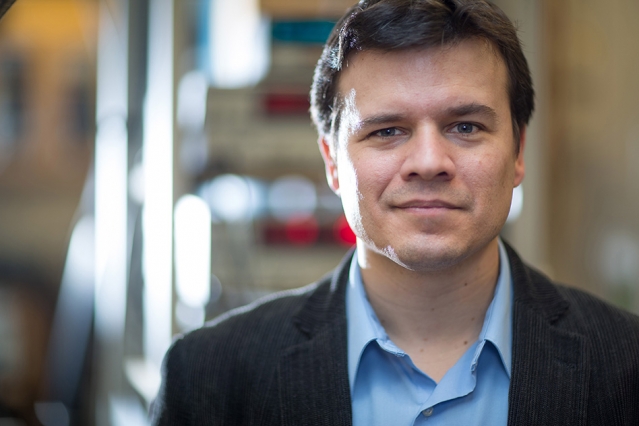Feb 24 2016
Ever since graphene was discovered in 2005, it has been hailed a wonder material with the potential to transform major industries, such as energy, health care, electronics, and construction.
 Pablo Jarillo-Herrero (Photo credit: Bryce Vickmark)
Pablo Jarillo-Herrero (Photo credit: Bryce Vickmark)
In Pablo Jarillo-Herrero’s lab, scotch tape was used to effectively isolated graphene. Graphene is a thin lattice of carbon atoms that is the world’s toughest and thinnest material.
Jarillo-Herrero believes in the limitless possibilities graphene has to offer in terms of its extraordinary properties. Using the scotch tape and immense patience, he removed graphite layers, and hoped to isolate a single, gossamer graphene sheet that measures only a single atom thick.
For a good fraction of our time, my grad students and I are just sort of playing, seeking to discover.
Jarillo-Herrero, Associate Professor of Physics, MIT
Jarillo-Herrero has been involved in researching the optical and electrical properties of graphene and other atom-scale thin materials, such as topological insulators and transition metal dichalcogenides. These ultrathin materials display quantum mechanical properties, which are capable of inducing amazing characteristics into the electrons passing through them. For instance, electrons passing via graphene are capable of traveling great distances without colliding against any barriers, making graphene the most powerful electrical conductor in the world, and a possible replacement for silicon.
Jarillo-Herrero is studying the electron flow via one sheet of graphene, stacked configurations, and a combination of other ultrathin materials. He exposes these “graphene nano-devices” to varied environmental conditions, including ultracold temperatures and powerful magnetic fields. To achieve this he fitted his lab with liquid helium cryostats, powerful magnets, and ovens to grow unique materials in.
In explaining his experimental method, Jarrillo-Herrero says that frequently, “we have something in mind, and we aim at that, but we’re secretly hoping something more interesting will happen, and we have fun exploring the unexpected behavior.”
When Jarillo-Herrero thought of a career in physics experimentation hardly crossed his mind. He completed his schooling in Valencia, Spain, where he took part in an international physics Olympiad, and developed an interest for solving theoretical problems. He went on to enroll in the University of Valencia and pursued theoretical physics.
In Spain, the theorists were the professors who had more prestige. High-energy theoretical physics was the cool thing to do.
Jarillo-Herrero, Associate Professor of Physics, MIT
A professor encouraged Jarillo-Herrero to apply for graduate programs in the U.S, he took the advice and got selected in the University of California at San Diego. His aim was to pursue a PhD in theoretical physics. However upon arriving in the U.S. he began to attend several seminars outside his core area, and was captivated by the progress made in experimental physics. Especially condensed matter physics, where researchers tried to control matter to investigate principles of quantum mechanics. Jarillo-Herrero then decided to go to the Delft University of Technology in the Netherlands to earn a PhD in condensed matter physics.
Jarillo-Herrero recalls that his decision to move from theory to experimental work was a challenging prospect. He realized that most of the graduate students in his program had completed a master’s degree in experimental physics, whereas he was learning the basics of experimental work.
For the first two-and-a-half years, I had zero results, no prospects of any results, and was constantly asking myself if maybe this was a mistake, maybe I should be a theorist after all. Then one day, in one experiment, we discovered something completely unexpected, and there was this explosion of results.
Jarillo-Herrero, Associate Professor of Physics, MIT
His first successful research was an experiment where he hung a carbon nanotube between two electrodes and studied the symmetric behavior of electrons and holes in quantum dots. This study was published in the Nature journal, and became Jarillo-Herrero’s first publication.
People say, luck has to catch you working. When you’re working around things you think are interesting, surprises happen often. And in condensed matter physics, things are often surprising. I would say that’s been a theme throughout my career.
Jarillo-Herrero, Associate Professor of Physics, MIT
After completing a one-year fellowship at Columbia University, Jarillo-Herrero joined the MIT faculty as an assistant professor of physics in 2008. His first year was tedious, having to balance the demands of research, teaching, and setting up his laboratory.
I tend to think of myself as a pretty slow starter. Like my PhD, MIT was similar: a little struggle to get started, not much happening, and then, vroom, things picked up, and things have been going quite well. It’s funny how things evolve sometimes.
Jarillo-Herrero, Associate Professor of Physics, MIT
Jarillo-Herrero received a number of awards, including a Presidential Early Career Award for Scientists and Engineers for his experimental work. This award gave him the opportunity to tour the White House and meet with President Obama.
As a foreigner, it’s relatively hard to actually visit the White House, so it was very inspiring.
Jarillo-Herrero, Associate Professor of Physics, MIT
He and his team are working with unique combinations of ultrathin materials, which could finally lead to highly powerful computer chips and advanced solar cells. Jarillo-Herrero is highly driven by the immense knowledge yet to be discovered.
Now there are many materials similar in spirit to graphene, meaning they can be obtained in atomically thin dimensions. We’re just playing with all of them, and combining them into interesting structures. The properties of those materials are hard to predict and unexpected. And that’s exciting.
Jarillo-Herrero, Associate Professor of Physics, MIT